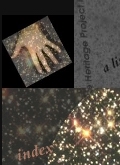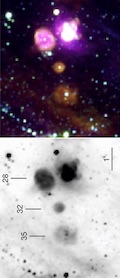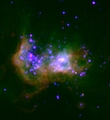



Calibration of nebular emission-line diagnostics: I. Stellar effective temperature
M.S. Oey, M.A. Dopita, J.C. Shields, R.C. Smith
We present a detailed comparison of optical H II region spectra to
photoionization models based on modern stellar atmosphere models.
We examine both spatially resolved and integrated emission-line
spectra of the H II regions DEM L323, DEM L243, DEM L199, and DEM
L301 in the Large Magellanic Cloud. The published spectral
classifications of the dominant stars range from O7 to WN3, and
morphologies range from Stromgren sphere to shell structure. Two of the
objects include SNR contamination. The overall agreement with the
predictions is generally within 0.2 dex for major
diagnostic line ratios. An apparent pattern in the remaining discrepancies
is that the predicted electron temperature is ~1000 K
hotter than observed. [Ne III] intensities are also slightly
Our analysis of the complex DEM L199 allows a nebular emission-line test of unprecedented detail for WR atmospheres. Surprisingly, we find no nebular He II 4686 emission, despite the fact that both of the dominant WN3 stars should be hot enough to fully ionize He I in their atmospheres. The nebular diagnostics are again in excellent agreement with the data, for stellar models not producing (He+)-ionizing photons. The optical diagnostics are furthermore quite insensitive to the ionizing energy distribution for these early WR stars. We confirm that the eta-prime emission-line parameter is not as useful as hoped for determining the ionizing stellar effective temperature, T_*. Both empirically and theoretically, we find that it is insensitive for T_* >~ 40 kK, and that it also varies spatially. The shock-contaminated objects show that eta-prime will also yield a spuriously high T_* in the presence of shocks. It is furthermore sensitive to shell morphology. We suggest [Ne III]/H-beta as an additional probe of T_*. Although it is abundance-dependent, [Ne III]/H-beta has higher sensitivity to T_*, is independent of morphology, and is insensitive to shocks in our objects. These observations should be useful data points for a first empirical calibration of nebular diagnostics of T_*, which we attempt for LMC metallicity. ApJS, 128, 511
|

